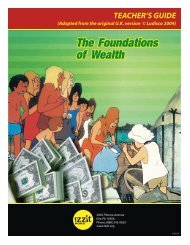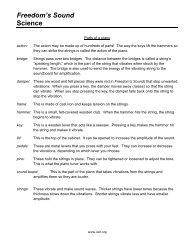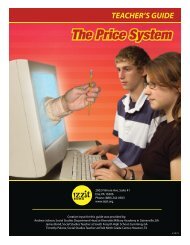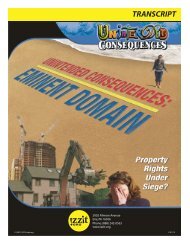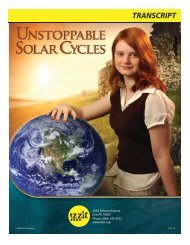Transcript - Izzit.org
Transcript - Izzit.org
Transcript - Izzit.org
You also want an ePaper? Increase the reach of your titles
YUMPU automatically turns print PDFs into web optimized ePapers that Google loves.
MAN: And for all but a few thousand of his one or two million years on this planet, this is how man<br />
really lived –hand-to-mouth, day-to-day and place-to-place. He followed the herds, eating any wild<br />
animals he could kill, and gathering whatever wild fruits and vegetables he could manage to find.<br />
WOMAN: But for most people… life began to change dramatically about ten thousand years ago, when<br />
human beings found the secret of staying in one place.<br />
MAN: The secret was farming, domesticating animals – pigs and cattle, sheep and goats – and<br />
cultivating crops. By finding that secret- man had stumbled on the path to prosperity.<br />
WOMAN: The first prosperous civilizations grew up in four great river valleys – the Yellow River in<br />
Northeastern China, the Indus in Pakistan, Tigris and Euphrates in modern Iraq and ancient Babylon and<br />
the Nile in Egypt.<br />
MAN: And yet, if you look at those great fertile valleys today you’ll find a strange thing. They are now<br />
among the poorest of the world’s nations, often unable to provide even enough food for their inhabitants.<br />
WOMAN: Until two or three hundred years ago, the richest countries were often the ones with the best<br />
land. But today, great industrial communities have been built up in the world using resources imported<br />
from other places. In other words, some of their wealth comes from foreign trade.<br />
MAN: There will always be strong disagreement about why some countries have followed the path to<br />
prosperity, and others haven’t.<br />
WOMAN: But of one thing there is little doubt. Those who have achieved it, have done so by creating a<br />
surplus…a big surplus, using exactly the same method as we did in our community. This factory, like all<br />
factories, is the result of division of labor by product…and the product is television sets.<br />
MAN: It produces them in a whole lot of different stages: Division of labor by process.<br />
WOMAN: It’s mechanized, and the production is achieved through devices like wheels, levers, gears,<br />
hinges and pulleys. Most of the energy comes from electricity supplied by harnessing the resources of<br />
nature: like water, coal, oil and uranium.<br />
MAN: As a result, a thousand people working in a factory like this turn out half a million sets a year –<br />
five hundred a year each. Since they don’t need them all for themselves- they’ve created a massive<br />
surplus of television sets to exchange.<br />
WOMAN: So in effect, they’ll be swapped for other people’s surpluses. For his share of the exchange a<br />
worker in a factory gets: food, clothing, heating, a house and a car- from other workers who produced<br />
more of those things than they needed.<br />
MAN: He also gets roads, street lighting, a teacher for his children, a doctor and a policeman as well.<br />
WOMAN: And after all that, he still has his evenings free to watch a television.<br />
MAN: Of course, he still has his problems and frustrations.<br />
WOMAN: But when you consider the subsistence level where it all started long ago, is there any doubt<br />
about which sort of life you would prefer<br />
23




